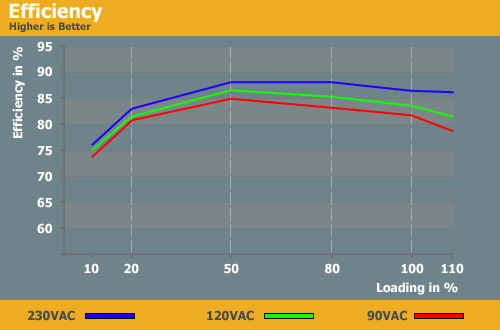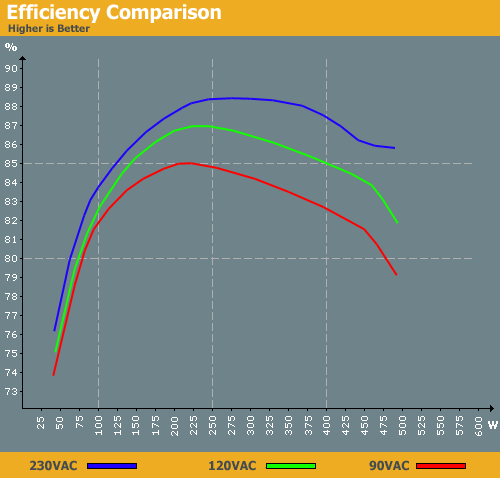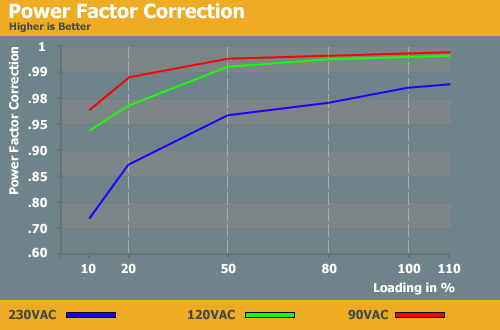Silverstone ST45NF Nightjar
by Christoph Katzer on August 25, 2008 1:00 AM EST- Posted in
- Cases/Cooling/PSUs
Efficiency, PFC and Temperatures


Using 230VAC, the Nightjar delivers efficiency of 88% from 225W to 375W. It then drops to 86%, which is still an excellent result. As the graph shows, the efficiency isn't as good with lower input voltages; optimal efficiency is obtained with loads of at least 100W, and the range of maximum efficiency is not the same as long as with 230VAC. Of course, even with loads of 50W to 75W it still manages at least 80% efficiency; while 88% might be more desirable, we are only talking about a difference of ~5W. What's the point in reaching 88% efficiency at 250W if you only need 50W?

The power factor correction looks good with lower input voltages, but we have seen much better results for 230VAC.

This unit does not have an exhaust temperature, which is why we attached the diode we normally use to measure the exhaust temperature to the power supply casing to measure the outside temperature. After loading the power supply for a while, we eventually reach a temperature that would allow us to cook an egg on the surface, but in fairness we have also seen hotter temperatures with some fan-cooled power supplies.
The outside surface reaches up to 58°C with 30°C ambient temperature. That's definitely not a bad result, and seeing the two heatsinks top out at 70°C makes us confident of its power supply's ability to run in systems with a single fan. However, temperatures are still increasing as we put an additional load on the PSU, and a higher ambient temperature would definitely result in higher PSU temperatures. We would be extremely hesitant to run such a power supply in a system where the ambient case temperature can reach 50°C or higher -- at least not without additional case fans, which defeats the purpose of the fanless power supply. Silverstone agrees with this, as they state the power supplies designed to operate in a 30°C ambient temperature.










20 Comments
View All Comments
TravisChen - Saturday, August 30, 2008 - link
Can you show us how to get test the output ripple & noise the right way (with the caps mentioned in spec)? I think it's an important part in PSU reviews.Christoph Katzer - Monday, August 25, 2008 - link
Actually that was just to take the screenshots... I still have pretty high spikes now and then even with the caps according to specs.tayhimself - Monday, August 25, 2008 - link
How does this address the point raised? And why are you taking pointless screenshots then?LTG - Monday, August 25, 2008 - link
Yes Tayhimself is right, Christoph you kind of avoided or skimped on a proper response to the questions raised.Authors replying in the comments is a major strength of AT - Please respect that.
So what was wrong, just your screen shots, or some of the testing reported originally as well?
Thank you.
Christoph Katzer - Tuesday, August 26, 2008 - link
I am still working on it to get the spikes sorted. With replying to that post I already meant to say that he was right and that his reply was much more helpful than most others that don't take the time to complete a full sentence... Once I sorted the spike-problem it will be all better.aarvark - Monday, August 25, 2008 - link
Really "of limited use"? A core duo with mid-range graphic card barely tops 150W these days. A basic setup, maybe with integrated graphics would be around 120W. 400W is more than plenty for 99%+ of the market. Remember, us geeks are the exception, not the rule.I'd say the one thing it wasn't suitable for were HTPCs whereby you'd be better off with a picopsu or the like as they are more efficient at very low loads and only $50. Better still by having an external brick most of the heat is outside the case.
Saying that I'm not a fan (no pun intended) of these because they are many, cheaper supplies that have a lazy 12 or 14cm thermally controlled fan which are for all real purposes silent anyway with the huge advantage of giving just a little case airflow through the case.
JarredWalton - Monday, August 25, 2008 - link
I think that last point is why we say "limited use". Basically, you need to want 200-300W of power (gotta leave some wiggle room, right?), and you need to want absolute silence, and you also need to be willing to pay $170+ for it. I'd take a 600W PSU with a large fan over this for under $100 as well. Pico PSUs are an option for small systems that don't require a lot of power, but there are many definitions of HTPC. Personally, I prefer larger systems with more storage options.Freddo - Monday, August 25, 2008 - link
Looks like something I would buy for my next computer :-)Clauzii - Monday, August 25, 2008 - link
The same here :)With specs and quality like that, it's almost impossible to go wrong with this. Also, the cablelengths COULD make it possible to let it rest outside the PC case itself (for DIYs anyway).
And thank You Anandtech, for testing a sub-500 Watt supply :)
pattycake0147 - Tuesday, August 26, 2008 - link
I agree not everybody wants kilowatt a psu a low wattage one like is an excellent change of pace and exactly what I am looking for.